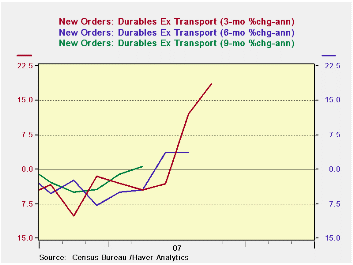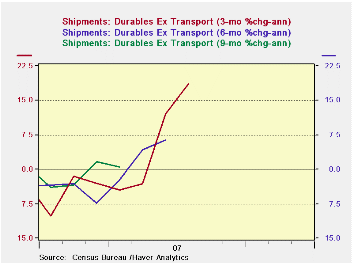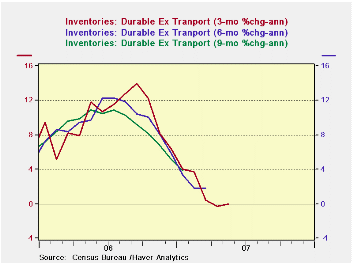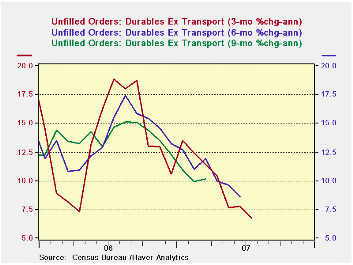 Global| Jun 27 2007
Global| Jun 27 2007U.S. Durable Goods Month Down, Trends Still Up - but for How Long?
Summary
The upswing in durable goods trends is still in progress although the weakness in May has reduced much of its clout and blunted the Yr/Yr gain. Durable goods orders are down by a sharp 2.8% m/m in May after gains of 1.1% in April and [...]

The upswing in durable goods trends is still in progress although the weakness in May has reduced much of its clout and blunted the Yr/Yr gain.
Durable goods orders are down by a sharp 2.8% m/m in May after gains of 1.1% in April and 5.1% in March. For non-transportation the May loss is -1% and compares to gains of 2.5% in April and 1.6% in March. The accompanying chars plot the trends from this series and they are still turning higher. Inventory growth is being cut to zero and order backlog growth is slowing, but still strong.
Inventory-to-sales ratios are being cut across sectors as shipment growth surpasses inventory growth in six of seven major industry groups over the past 3 months. That result holds for five of seven industries over a six month horizon as well. Yr/Yr, however, inventory growth has still surpassed the growth in shipments for ALL seven industries, indicating why stock-paring is still going on. Over three months inventories were cut outright in three of seven industries.
These statistics describe a sort of running correction in the durable goods sector. Shipment growth rates are extremely strong (annualized) over the past three months. Six-month growth in shipments is mostly firm to strong across sectors, but much more varied. Yr/Yr shipment growth is mostly modest to weak. So the recent strength has not vaulted trends into a strong positive reading.
Regional MFG surveys released this month carrying data for the month of JUNE have been strong for the most part: NY, Philadelphia and Richmond (the Dallas report that is new and not seasonally adjusted was an exception) were all strong.
Reliability diminished? The monthly pull back in orders is in keeping with the usual volatility of the sector although volatility has grown beyond what has been normal in recent months. Out of 170 observations of 12-month volatility (standard deviation of m/m % changes over a moving 12-month period) the 4.7% volatility reading in May ranks 20th which puts it in the top 12% of all volatility rankings in the past 14 years. And the high volatility is not just ‘May’ it is a result that is shared among recent months. While m/m ex transportation orders do not seem to have become more volatile, the volatility of Yr/Yr ex-transportation orders series is quite high. We have no choice but to admit that the orders series has been blasted with volatility from several sources and has become LESS RELIABLE. There is some evidence that shipments may also have been afflicted with extra volatility.
While the ISM reports and other regional MFG surveys continue to be upbeat, they map into the durable goods data rather too-poorly to assess any change in pattern there. Suffice it so say that with the regional MFG surveys for a more current month so strong it is reasonable to think that the downshift in durable goods orders in May is not some step back but is still part of what erratic orders do in an expanding cycle. Still, with this sort of sharp drop in May orders, all eyes will be more firmly glued on what happens in June.
  |
| Inventory-Shipment Balance By Major MFG Sector and Tenor | ||||||
|---|---|---|---|---|---|---|
| 2007.May | 3-months | 6-months | 12-months | |||
| Major Sectors | Shipments | Inventory | Shipments | Inventory | Shipments | Inventory |
| Primary metals | 36.5% | 6.7% | 14.9% | 1.5% | 4.1% | 10.8% |
| Fabricated Metal Products | 10.9% | 1.5% | 7.9% | 2.2% | 1.9% | 7.2% |
| Machinery | 24.2% | 2.5% | 3.3% | 7.9% | 2.2% | 7.2% |
| Computers and Electronics | 25.3% | -4.0% | 6.5% | -1.5% | 3.6% | 5.0% |
| Electrical Equipment, Appliances & Computers | 9.2% | -1.1% | 13.6% | 2.0% | 4.0% | 7.3% |
| Transportation Equipment | 10.4% | 12.0% | 0.6% | 7.4% | -2.1% | 7.7% |
| All Other Durables | 8.2% | -3.6% | 1.3% | -1.0% | -4.0% | 2.0% |
| % Sectors with rising I/S Ratio: | 14.29% | -- | 28.57% | -- | 100.00% | -- |
Robert Brusca
AuthorMore in Author Profile »Robert A. Brusca is Chief Economist of Fact and Opinion Economics, a consulting firm he founded in Manhattan. He has been an economist on Wall Street for over 25 years. He has visited central banking and large institutional clients in over 30 countries in his career as an economist. Mr. Brusca was a Divisional Research Chief at the Federal Reserve Bank of NY (Chief of the International Financial markets Division), a Fed Watcher at Irving Trust and Chief Economist at Nikko Securities International. He is widely quoted and appears in various media. Mr. Brusca holds an MA and Ph.D. in economics from Michigan State University and a BA in Economics from the University of Michigan. His research pursues his strong interests in non aligned policy economics as well as international economics. FAO Economics’ research targets investors to assist them in making better investment decisions in stocks, bonds and in a variety of international assets. The company does not manage money and has no conflicts in giving economic advice.






